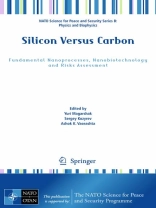Even though there is no generally accepted definition of nanotechnologies to be defined as distinct discipline there is an emerging consensus that their advent and development is a growing in importance factor of the contemporary and future technological civilization. One of these most fundamental issues we are confronted with is the compatibility with life itself. From single cell organisms to humans, carbon is a key building block of all molecular structures of life. In contrast the man created electronic industry to build on other elements, of which silicon is the most common. Both carbon and silicon create molecular chains, although different in their internal structure. All life is built from carbon-based chains. As long as the man built technological products do not directly interfere with the physiology of life the associated risks from them are relatively easy to identify. They are primarily in the environmental pollution and the possibility of upsetting the natural balance of biocoenosis, on a planetary scale. The basic life functions are still not directly subverted. We can use TV, computers, drive cars and use other technological utilities without fear of direct interference with our cellular functions. This is in particular because all these technological utilities are many orders of magnitude larger than typical scales of biological activity. Most of biological activity, from fermentative catalysis to DNA replication takes place on nanoscale. The situation is radically different when the technological goals are building nanoscale size products. All biological processes take place on nanoscale.
Table of Content
Preface. Is ‘Silicate Life’ Possible?; L. Gribov et al.- Nanocarbon Technologies: Prospects and Risks; S. Kozyrev, P. Yakutseni.- Advanced Environment Friendly Nanotechnologies; O. Figovsky et al.- Novel Environment Friendly Method of Preparing Nano reinforced Composites Based on Metallic, Ceramic and Polyrner Matrixes — Super deep Penetration; S. Usherenko, 0. Figovsky.- SDP Technology for ‘Green’ Technology of Metallic Reinforced Nanocomposites; J. Owsik, S. Usherenko.-Substantiation of International Nanomaterials Security Group Creation; A. Sosnov et al.- Matter Structuring at Nano Scales and Fundamental Constants of Physics; E. Kapuscik.-Size Evolution of Nano clusters: Comparison between the Phase Diagram and Properties of Mo-S and Carbon Nanoparticles; R. Tenne.- Nanomaterials Nexus in Environmental, Human Health, Sustainability; A. Vaseashta.- Nanotechnology & Quasi-crystals: From Self Assembly to Photonic Applications; R. Lifshitz.- Oscillations of Polarized Charge in Solution of Salt in Polar Dielectric: Possible Application in Element and Isotope Separation in Biology and Nanotechnology; M. Kazaryan et al.- On the Possible Influence of Resonance Conversion on Formation of the Organic Structures; F. Karpeshin, Yu. Magarshak.- Field Driven Current in Nonlinear Low-dimensional Nanosystems;L. Brizhik et al.- The Impact of Novel Technologies on the Environment throughout History; P. Ilyinskii.- Nano Techno Science as a cluster of the different natural and engineering theories and nano ethics; V. Gorokhov, H. Lenk.- Risk in Decision-oriented and Self-Changing Society; G. Bechmann.- Technology-Induced and Environment Risks in History; Ya. Rabkin.- Nanotechnology: Perspective for Future and Nanorisks; V. Gorokhov, V. Stepin.- Evaluation of Sustainability of Carbon & Silicon Ecosystem: from Nanoparticles to Macro world; V. Dolin.- Carbon Discs and Carbon Cones — New High Risk Materials for Nano Sensors with Low Detection Limit and Fast Kinetics; J. Muller et al.- Biodynsensing: Sensing through Dynamics of Hybrid Affinity / Cellular Platforms; towards Appraisal of Environmental and Biological Risks of Nanobiotechnology; E. Gheorghiu et al.- Synthesis and Utilization of Hyperbranched Poly(amino acids) as Carriers of Biologically Active Substances: Problems and Solutions; G. Vlasov.- Biodegradable and Biocompatible Carbon-chain Polymer-protein Conjugates as Carriers of Biologically Active Substances: Problems of Synthesis, Risks of Application and How to Overcome Them; G. Vlasov.- Modem Risks of the Antropogenic Influence on Living Spieces: Nanolevel Fluctuation; I. Ruban et al.- Application of Fulleroid Nano-Carbon in Sorption Techniques; V. Samonin et al.- Aspects of Microparticale Utilization for Potentiation of Novel Vaccines: Promises and Risks; P. Ilyinskii.-Subject Index. List of Contributors.
Language English ● Format PDF ● Pages 416 ● ISBN 9789048125234 ● Editor Yuri Magarshak & Sergey Kozyrev ● Publisher Springer Netherland ● City Dordrecht ● Country NL ● Published 2009 ● Downloadable 24 months ● Currency EUR ● ID 2220825 ● Copy protection Adobe DRM
Requires a DRM capable ebook reader












